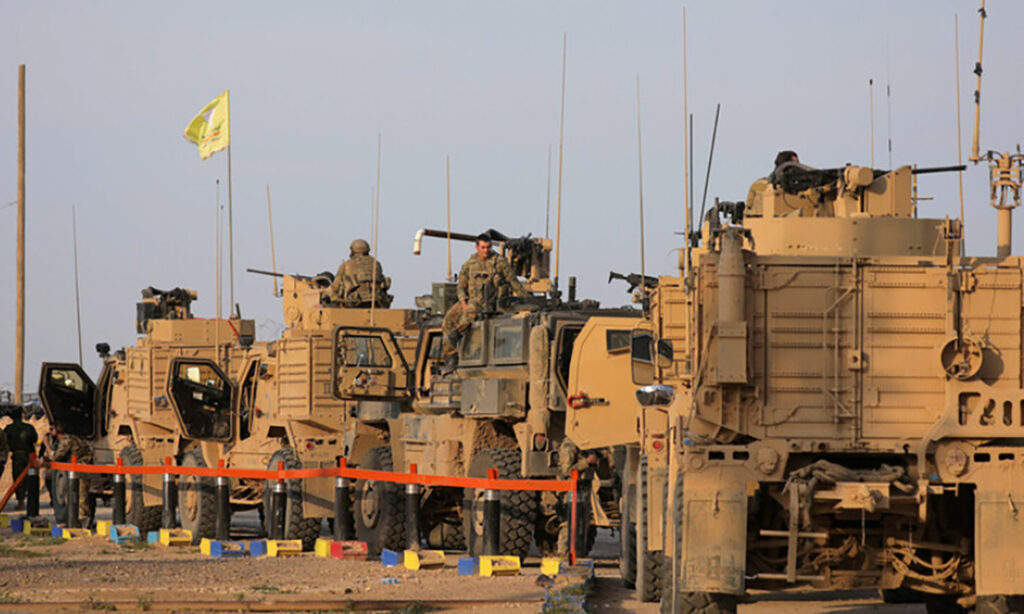Since the beginning of this year, the targeting of the al-Omar oil field, which has the largest US base in Syria, by Iranian-backed militias based near the region east of Deir Ezzor has escalated.
The most recent of these attacks was on 18 September, when the US Central Command (CENTCOM) announced in a statement that the Green Village (an area inside the base) was targeted with three 107 mm rockets.
US forces always respond to attackers with artillery shells or with aerial bombardment carried out by their fighter aircrafts, according to what they announced last August several times in a row.
The military base in al-Omar oil field
With areas of northeastern Syria crowded with military forces fighting the Islamic State (IS) in 2017, the region saw a race between the US-backed Syrian Democratic Forces (SDF) and Russian and Iranian-backed Syrian regime forces to control as many IS territories as possible.
On 22 October 2017, SDF announced that its forces, with the support of the International Coalition Forces (ICF), had taken control of the al-Omar oil field, Syria’s largest, after the regime’s alliance had engaged in military operations against it for days.
As SDF installed its spheres of influence in the region as far as the Euphrates River from the eastern side, the al-Omar field is now known as the largest US military base in Syria.
The field in Deir Ezzor’s eastern countryside is the largest oil field in Syria, with a pre-Syrian revolution production of about 30,000 barrels per day.
The field includes a gas plant and a power plant. In the past years, however, it has been subjected to dozens of airstrikes by the International Coalition after IS took control of it, which has left it significantly damaged.
Map showing the location of the al-Omar oil field in the countryside of Deir Ezzor (edited by Enab Baladi)
What does the base have to do with oil?
Over the past years, the Syrian regime media and Russia have attempted to portray the US presence in the region as a “theft of Syrian oil,” linking the American presence in the eastern region of Syria to the region’s richness in oil.
Muzahim al-Salloum, a researcher in government contractor issues, told Enab Baladi that, apart from “conspiracy theories,” the US presence in the region is solely linked to the region’s strategic value.
He noted that the Syrian situation makes the oil file a burden for US troops and not an advantage, especially after uncovering files about corruption by members of the US military in Iraq’s oil sector years ago. In addition, these fields are exposing the US to internal pressure posed by the Turkish lobby in the United States, as most of the revenues from the oil wells in northeastern Syria go to the Kurdish parties designated on Turkey’s “terrorism” lists.
Former US President Donald Trump tried to justify his retreat from the withdrawal from Syria with oil that could be used by the US. But ultimately, this hypothesis cannot be taken seriously, according to the researcher.
In February 2020, Trump said it was time for his country to pass the fight against IS to Russia, Iran, Iraq, and Syria, focusing instead on maintaining control over the region’s oil resources.
He continued, “We took the oil, and our soldiers there are the ones guarding it. We have oil, and that is all we have there”, according to the US magazine Newsweek.
The region’s strategic importance
The al-Omar field is located in a strategic area at the geographical level, and also because of the social composition of the area, according to the researcher. The areas around the field are the stronghold of the al-Agaidat clan (the largest clan in the eastern region).
The al-Omar field is also in the middle of all areas requiring US action in the region, such as the city of al-Bukamal (the stronghold of the Iranian Revolutionary Guards in Deir Ezzor), in addition to the areas of al-Baghouz and al-Busira, which are witnessing movements of IS cells.
The facilities inside the field also enable the forces to be stationed and build fortifications inside it, as al-Salloum considered it an appropriate place to build a security fort within which troops can move freely.
US-controlled fields
The most important Syrian oil and gas fields are located in the governorates of Deir Ezzor and al-Hasakah, as US forces are in control of the al-Omar oil field, which is the largest oil field in Syria in terms of area and production capacity, in addition to a group of other fields, including the Tanak oil field (the second largest oil field in Syria after al-Omar field) located in the al-Shaitat desert in the eastern countryside of Deir Ezzor.
There is also the al-Shaddadi oil field (east of al-Hasakah), and it is considered one of the largest oil fields in Syria, which has been SDF-held ever since the expulsion of IS from the region back in 2017. The Koniko gas field (located in the northern countryside of Deir Ezzor), Syria’s largest gas processing plant, is also used in electrical power production.
The three fields are estimated to produce 140,000 to 150,000 barrels of oil per day. The production was about 386,000 barrels per day in 2010, at a time when Syria’s consumption was estimated at about 250,000 barrels per day, according to cross-referenced sources such as BBC and Business Insider.











